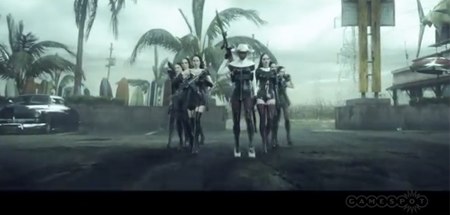Hitman Absolution
Mark Bernstein

The always-insightful media critic Susana Pajares Tosca joins the chorus of scorn heaped on the Hitman Absolution game trailer.
“Ok I come late to all discussions, but this is awfully horrible. I am most shocked though at the actual trailer and the comments to that trailer in youtube by incredibly damaging shitbrained chauvinist morons! this is where you think: why the hell do I touch videogames at all?”
What’s missing here, and in the Brendan Keogh condemnation to which Tosca links, is a sympathetic effort to understand what the trailer is trying to say, an effort to explain why it does what it does. Demonstrating the existence of “rape culture” is simply strutting one’s superior virtue.
Instead, we might ask what’s going on in this strange demonstration of a scene from a forthcoming game. Robert Polito’s essay on Pauline Kael, “Finger In The Fuse” (in the current issue of Harpers) is a nice reminder of what criticism can accomplish. Let’s take a shot.
We open with a gray sky, wind-blown dust, and a seedy motel. The motel is a class marker and a genre hint. James Bond never stayed in a dump like this. We’re downmarket, and we’re going to hell.
A thick, brutal, isolated hero dresses his wounds. More class markers: this fellow has walked down plenty of mean streets. He has scars. He hurts, but he has a job to do. He is preparing in isolation for an ordeal, so we know he must be the hero. He is calm and unhurried.
A group of assailants approach. They are costumed as nuns, or rather as a sexy travesty of nuns. They are numerous and they are well armed. Their slimness and elegant dress are class markers, too.
The nuns tear off their habits, revealing latex and leotards. They line up and prepare to fire rocket-propelled grenades and automatic weapons at our hero’s room. They plan, literally, to shoot him in the back.
Why are they nuns? And why do they undress before trying to assassinate the hero? This is a very strange way to behave. We could assume that the game designers did this to support rape culture and endorse the Republican ticket, and if that convinces you I’ve got a great tinfoil hat for you to try. Instead, let’s assume that the designers are trying to do something that seemed like a good idea at the time — let’s generously assume they are decent men and women — and try to figure out what’s really going on.
We’re in a Western. In fact, we’re in the scene where the Cowardly Opponent tries to shoot us in the back. The conventional markers of the genre — horses and hats — have been dispensed with, but we now have our genre bearings. (Until this point, we might have been in a spy thriller.)
We all have read about the male gaze. The shots that Keogh finds especially objectionable are not in fact establishing the sexual attractions of the assassins, but rather the cinematographic authority of the game creators. The shots argue that the creators understand film grammar and promise that the game will offer interesting camera work – something we’ve wanted for a long time and that has turned out to be hard to get right. This is inside baseball, but it takes about six seconds to make the argument. (The torn fishnets are also a class marker, of course, but like the camera work they mark a class that is not precisely the one that first comes to mind.)
The aesthetic problem of the Western is our sympathy with the enemy. The superhero power fantasy demands that we can overcome numerous enemies that are inhuman, and so deserve to be overcome. In the bad old days, the enemy were bands of native Americans who were waging a race war against us. When this became preposterous, the enemy were corrupt and wealthy Easterners, or the ever-useful Nazis. In science fiction, the enemy are alien bugs. The enemy is like us, but they are not us. They look strange, and act strangely, and do strange stuff. The bugs shed their carapaces before combat.
The whole point is that the “merciless sisters” are inhuman. Their makeup renders them faceless. Their dress distances them from us. Their behavior shows that them to be ruthlessly inhuman. This is a world of violence, but the violence must adhere to rules, and the first rule is, you always face your enemy.
The Western’s second aesthetic problem is that its intended (or expected) audience is composed of young men. The Hollywood Western famously tried to address this with a Love Interest. That helped make the films acceptable to dating couples, at least when the Last Picture Show was the conventional prelude to making out, but it was never entirely satisfying. Games need not be experienced by couples; we don’t require mawkish and sentimental interludes. This frees us to cast women as the enemy. (Ian Fleming figured this out, too, for the spy thriller: Bond meets women who are Good, Evil, and Useful, and sorting them out is a full-time job.)
To the isolated hero, everyone is alien. Especially women. The combination of ridiculous, parodic clothes, absurd parodic makeup, risible parodic weaponry, and cowardly tactics lets us contemplate combat without losing sleep over the people we’re killing. This is essential for the genre, as it’s essential for the warrior. When you start thinking about the machine-gunner’s girlfriend, his aged mother, his plans to open a nice little Konditorei once they let him go home, that’s when you get your men killed.
Power fantasies are not more palatable if all the victims are male.
Down these mean streets a man must go. You don’t have Philip Marlowe to dinner. He’ll bleed on the tablecloth. You won’t like his manners; he doesn’t much like them himself. James Bond kills hundreds of minions casually and without remorse, and he makes sure that every girlfriend who betrays him dies horribly. Shane, Spenser, Mattie Ross, the guy who shot Liberty Valance: these people are necessary, perhaps, but they’re dangerous and unpleasant and most of the time you really don’t want them around.
And, incidentally, we’ve got some really complicated game mechanics. The remaining 1:40 of this 2:34 trailer is entirely about promising game complexity and depth by showing how complicated combat can be. I expect there are lots of technical cues here for people who have played lots of these games, but they’re over my head.
There’s nothing about rape, or sex, or women here, not beyond the premise that the “merciless sisters” can stand as inhuman. I’ve written elsewhere that, for preadolescents, adult women fall into the uncanny valley, the nightmare of beings not-quite-like ourselves. Those kids are also, if you recall, quite interested in greasy, grimy gopher guts, mutilated monkey meat, and french-friend parakeet.
Like our hero, little boys and girls can sometimes be nasty people you wouldn’t really want to invite to dinner if you could avoid it. You might not like that, but that’s the world we know. And we can tut-tut all we want about the nuns, just like our parents tut-tutted about Mad Magazine and those gopher guts, and look how well that turned out.
— MB, writing for myself, because our editor is somewhere in California and will likely rebut this presently.
